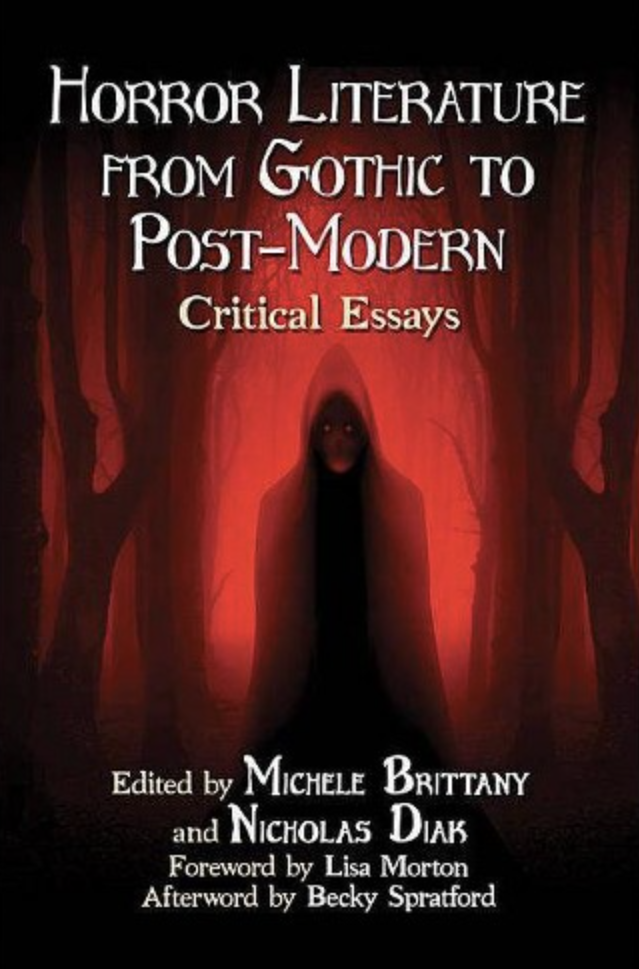Cemetery Dance, December 2020 |
|
Review by R. B. Payne
Horror Literature from Gothic to Post-Modern: Critical Essays Edited by Michele Brittany and Nicholas Diak McFarland Publishing Horror fiction is a popular genre for millions of readers but are these tales of terror and fear worthy of academic analysis? Of course they are! And, under the sheltering wings of StokerCon®, the Ann Radcliff Academic Conference brings literary scholarship to gruesome and terrifying horror books, comics, art, cinema, music, poetry, television, and video games. One of the most enjoyable aspects of being a reader is the journey of discovery when you learn that all stories have literary roots, whether acknowledged or not. That means on any given stormy night, you can dig into a contemporary novel understanding that it is constructed upon subconscious layers of the work of authors that have gone before. So, when you play a modern video game with zombies, read the latest and greatest graphic novel, or view a late-night ‘don’t go into the woods alone’ film, you can do so with the knowledge that the subtext and structure are well-designed to grab your pounding heart and rip it out. So, if you haven’t heard of Ann Radcliff, that’s a good place to start. Most readers assume that horror was birthed from Mary Shelly, Bram Stoker, M. R. James, or perhaps Wilkie Collins. These are likely landing points when one decides to dig into the past. But there was someone that preceded them all. SCENE: England, sometime around 1780 or 1790. The most popular novelist in the English language world is Ann Radcliff, a writer extraordinaire of Gothic fiction. In fact, she is its pioneer. In contemporary terms, Ann created the genre, popularized it, and then wrote multiple bestsellers. She was Shirley Jackson, Steven King, and Daphne du Maurier all fused into a single author. Everything that we treasure about our beloved horror genre most likely started with her. In the volume, HORROR LITERATURE FROM GOTHIC TO POST-MODERN: CRITICAL ESSAYS, editors Michele Brittany and Nicholas Diak have gathered fourteen essays which explore the past, present, and future of horror in all its incarnations. From presenting horror writers who forged new ground, to examining the literary theory of horror, to considering NIGHT OF THE LIVING DEAD and THE RING as harbingers of disease, viruses, and death, this volume presents essays which present thought-provoking articles on a wide variety of topics. Let me touch upon each section and provide a couple of highlights. In SECTION ONE: HORROR WRITERS WHO FORGED NEW GROUND, the authors examine Ann Radcliff’s GASTON DE BLONDEVILLE, social chaos in Max Brook’s WORLD WAR Z and the underlying meanings revealed in Robert Louis Stevenson’s JEKYLL AND HYDE. This latter essay by Erica McCrystal really intrigued me and I enjoyed it immensely. Certainly, it will improve my future story telling. To sum it up, J&H examined the concept of duplicity and identity. Can we really know what’s inside that attractive and alluring person who just chatted us up at a bar… and offered to walk us home? In SECTION TWO: SPOTLIGHTING HORROR WRITERS, the authors explore writers that we may, or may not have, been familiar with such as Marjorie Bowen, L.T.C. Rolt, Richard Laymon, and Stephen King. I especially enjoyed the essay by Gavin F. Hurley as he explored Richard Laymon’s Rhetorical Style. This essay, for me, was the highlight of this volume. In SECTION THREE: EXPLORING LITERARY THEORY IN HORROR, the authors delved into a diverse selection of topics, all of them fascinating. From symptoms of possession to children’s horror books to aboriginal dreaming, and finally arriving at the Gelatinous Green Immensity, this section was the most thought-provoking. Johnny Murray’s examination of Weird Fiction and the Grotesque Sublime was riveting, not to mention, enjoyable to the nth degree. In SECTION FOUR: DISEASE, VIRUSES, AND DEATH IN HORROR, the authors examine eerily relevant topics. Viruses. Disease. Death. The deep-dive look at NIGHT OF THE LIVING DEAD is hopefully not a variant preview of our COVID-19 future. THE RING novel (and film) is examined and the essay tries (and succeeds IMHO) in answer the question of what literary touchpoints were tingled thus spawning a global phenomenon. To wrap up the book, the final essay explores digital unease from a horror perspective. We all know that technology is moving faster and faster and outstrips our ability to manage the complications and dangers that may be introduced. Having spent my entire career working in technology, I found Rahel Sixta Schmitz’s analysis disturbing in its assessment and makes me think I am not safe in any digital future. The exploration of epidemiological maps makes me think of what we see on the news every day right now and what it portends. HORROR LITERATURE FROM GOTHIC TO POST-MODERN: CRITICAL ESSAYS is time well-spent and I highly recommend the book. Not all the essays are of equal interest, but there are more than a few tasty morsels for each and every reader. When we read for pleasure, the process has been proven to be enhanced when additional knowledge and sub-text can be retrieved by the brain. For example, if you were reading the original Dracula, the experience might well be enhanced if you were familiar with Johann Wolfgang’s THE BRIDE OF CORNITH, Sheridan le Fanu’s CARMILLA, or VARNEY THE VAMPIRE by James Malcolm Rymer. None of these are necessary the first time you read DRACULA, but they may make the second and third reading of Bram Stoker’s classic just that much more enjoyable. For me, this is one of the biggest contributions of the Ann Radcliff Conference. I rely on them to provide mind-expanding information which further enhances my enjoyment of the horror genre. At every StokerCon® that I have attended in the past few years, I have sought out their illuminating sessions. (c) 2020 by R. B. Payne, All Rights Reserved |
